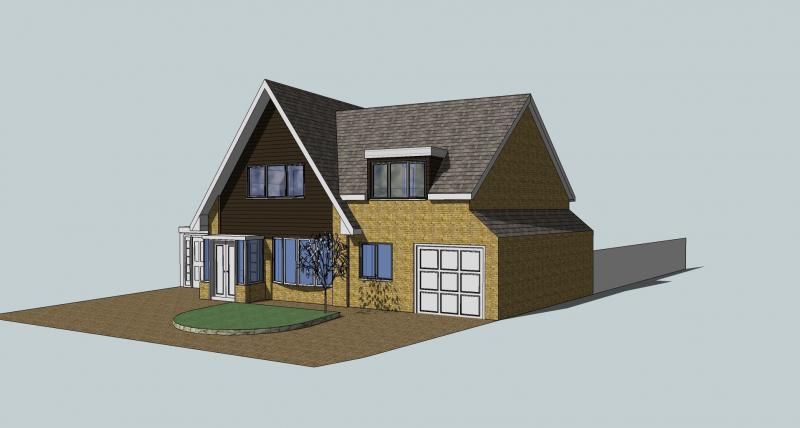Hi all,
I’ve had the first draft of the designs back from my designer and they’re not entirely what I was expecting.
My original brief given to the designer was that I wanted to build an extension (5.5m wide, 9.5m deep on ground floor) with a pitched roof that would allow an attic room with front dormer to be built in the roof space above the extension.
There is a complication in that the only possible entrance to the new dormer room (via existing window at the top of the stairs) is approximately 3.5m from the back of the house – therefore not centered to where the highest point of the new roof would attach to the house.
Well the plans have come back now, and they’re a bit different to expected. The designer has basically drawn up all the walls to be 1.5 storeys – with a pitched roof similar to that of the existing roof (17 degrees). The new roof actually goes to the same height as the ridge of the existing property.
The design looks good (better than my original idea), but I imagine that such a design is going to cost a lot more than anticipated as not only do I have the expense of building another half storey, but I am guessing that such a design will require specialist roof trusses (scissors or double inverted – from google) in order to make the first floor space useable.
I’m going to have a chat to the designer, but would really value some independent input from you guys on here so I can form an opinion before asking for revisions to the design. The things I’m not really clear on are:
Is there any reason why the new roof cannot be at a steeper pitch than the original roof (providing it won’t be higher than the existing ridge)? – I am thinking that with a steeper pitch then roof would join the front walls at a lower height and thus reduce the need for additional brickwork on those walls.
Are specialist roof trusses considerably more expensive than standard attic room trusses? Are the any additional complications with such trusses – I read on one website that scissors trusses are more difficult to insulate sufficiently.
Could it actually be wiser to install a second staircase to access the new room attic room rather that trying to modify the design to meet up with the potential opening that’s already there?
Thanks in advance
I’ve had the first draft of the designs back from my designer and they’re not entirely what I was expecting.
My original brief given to the designer was that I wanted to build an extension (5.5m wide, 9.5m deep on ground floor) with a pitched roof that would allow an attic room with front dormer to be built in the roof space above the extension.
There is a complication in that the only possible entrance to the new dormer room (via existing window at the top of the stairs) is approximately 3.5m from the back of the house – therefore not centered to where the highest point of the new roof would attach to the house.
Well the plans have come back now, and they’re a bit different to expected. The designer has basically drawn up all the walls to be 1.5 storeys – with a pitched roof similar to that of the existing roof (17 degrees). The new roof actually goes to the same height as the ridge of the existing property.
The design looks good (better than my original idea), but I imagine that such a design is going to cost a lot more than anticipated as not only do I have the expense of building another half storey, but I am guessing that such a design will require specialist roof trusses (scissors or double inverted – from google) in order to make the first floor space useable.
I’m going to have a chat to the designer, but would really value some independent input from you guys on here so I can form an opinion before asking for revisions to the design. The things I’m not really clear on are:
Is there any reason why the new roof cannot be at a steeper pitch than the original roof (providing it won’t be higher than the existing ridge)? – I am thinking that with a steeper pitch then roof would join the front walls at a lower height and thus reduce the need for additional brickwork on those walls.
Are specialist roof trusses considerably more expensive than standard attic room trusses? Are the any additional complications with such trusses – I read on one website that scissors trusses are more difficult to insulate sufficiently.
Could it actually be wiser to install a second staircase to access the new room attic room rather that trying to modify the design to meet up with the potential opening that’s already there?
Thanks in advance


